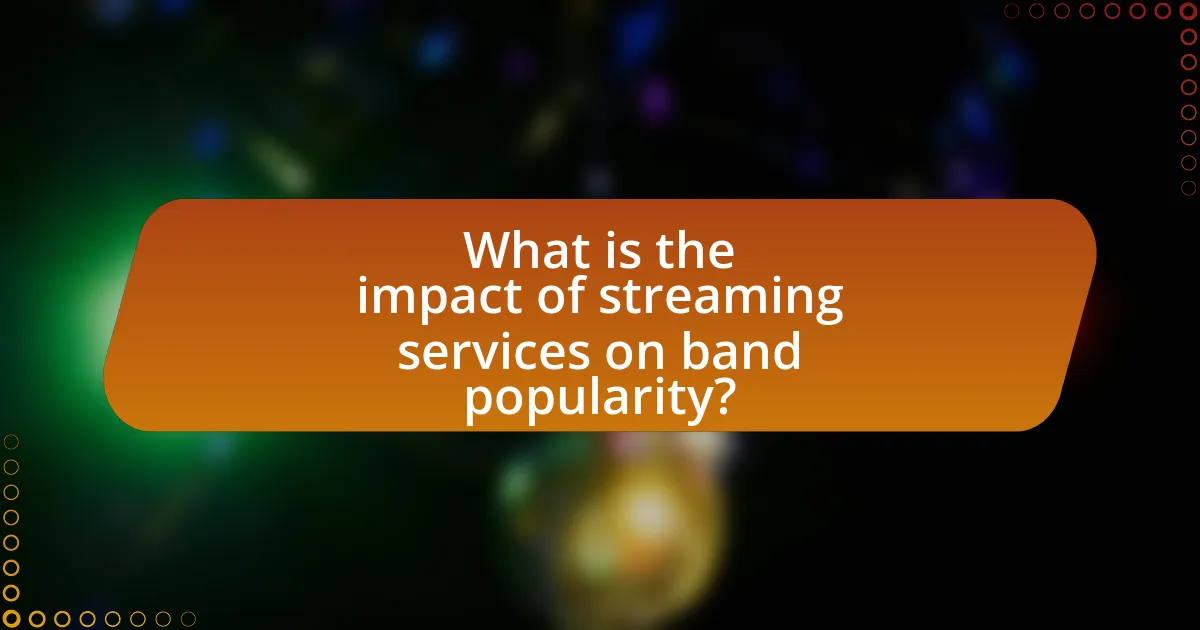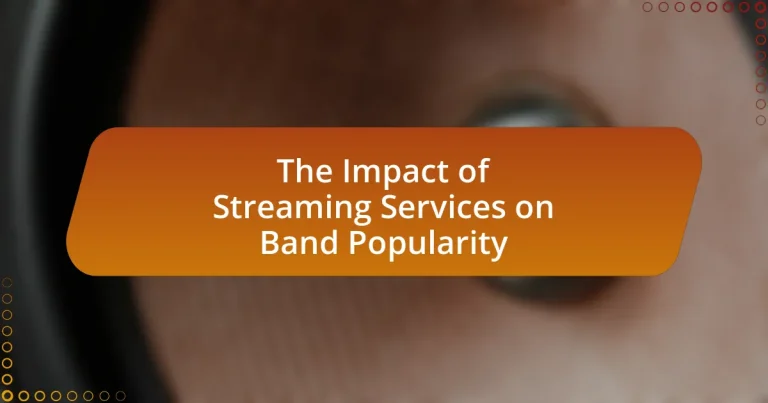The article examines the impact of streaming services on band popularity, highlighting how platforms like Spotify and Apple Music enhance music accessibility and facilitate artist discovery. It discusses the transformation of the music industry due to streaming, including changes in revenue models and consumption habits. Key metrics defining band popularity, such as streaming numbers and social media engagement, are analyzed, along with the financial implications of streaming royalties. The article also explores the advantages for emerging bands, the strategies established bands use to maintain relevance, and the challenges faced in a competitive digital landscape. Finally, it addresses future trends in streaming and best practices for bands to thrive in this evolving environment.

What is the impact of streaming services on band popularity?
Streaming services significantly enhance band popularity by providing widespread access to music and facilitating discovery. These platforms, such as Spotify and Apple Music, allow listeners to explore diverse genres and artists, leading to increased exposure for bands. For instance, a report by the International Federation of the Phonographic Industry (IFPI) in 2021 indicated that 70% of music listeners discover new music through streaming services. This accessibility not only boosts streaming numbers but also translates into higher concert attendance and merchandise sales, as bands gain a larger fan base.
How have streaming services changed the music industry?
Streaming services have fundamentally transformed the music industry by shifting revenue models from physical sales to digital consumption. This transition has led to a significant increase in music accessibility, allowing listeners to access vast libraries of songs for a subscription fee or for free with ads. According to the Recording Industry Association of America (RIAA), streaming accounted for 83% of the U.S. music industry’s revenue in 2020, highlighting its dominance over traditional sales methods. Additionally, streaming platforms have enabled artists to reach global audiences without the need for traditional record labels, thus democratizing music distribution. This change has resulted in a surge of independent artists gaining popularity, as evidenced by the rise of platforms like Spotify and Apple Music, which provide analytics and promotional tools that empower musicians to connect directly with fans.
What role do streaming platforms play in music distribution?
Streaming platforms serve as primary channels for music distribution, enabling artists to reach global audiences efficiently. These platforms, such as Spotify, Apple Music, and Amazon Music, provide a digital infrastructure that allows musicians to upload their work, making it accessible to millions of listeners instantly. According to the Recording Industry Association of America (RIAA), streaming accounted for 83% of the U.S. music industry’s revenue in 2020, highlighting the significant role these services play in monetizing music. Additionally, streaming platforms utilize algorithms to recommend music, which can enhance an artist’s visibility and popularity, further demonstrating their impact on music distribution and artist success.
How do streaming services influence music consumption habits?
Streaming services significantly influence music consumption habits by providing instant access to vast libraries of music, which alters how listeners discover and engage with artists. This accessibility encourages users to explore diverse genres and artists they might not have encountered otherwise, leading to increased exposure for emerging musicians. According to a 2021 report by the International Federation of the Phonographic Industry (IFPI), 62% of global music listeners use streaming services as their primary way to access music, highlighting a shift from traditional purchasing methods to on-demand listening. This transition has resulted in a decline in physical album sales and digital downloads, as streaming platforms prioritize playlists and algorithm-driven recommendations that shape user preferences and listening patterns.
Why is band popularity important in the current music landscape?
Band popularity is crucial in the current music landscape because it directly influences streaming revenue and audience reach. Popular bands attract larger listener bases on platforms like Spotify and Apple Music, which in turn leads to increased streaming numbers and higher payouts from these services. For instance, according to a 2021 report by the Recording Industry Association of America, streaming accounted for 83% of the music industry’s revenue, highlighting the financial significance of popular artists. Additionally, a band’s popularity can enhance opportunities for live performances and merchandise sales, further solidifying their presence in the industry.
What metrics define band popularity today?
Metrics that define band popularity today include streaming numbers, social media engagement, and concert ticket sales. Streaming platforms like Spotify and Apple Music provide quantifiable data on how often a band’s music is played, with millions of streams indicating significant popularity. Social media metrics, such as follower counts, likes, shares, and comments, reflect audience engagement and can influence a band’s visibility and reach. Additionally, concert ticket sales serve as a direct measure of a band’s fanbase and market demand, with sold-out shows indicating strong popularity. These metrics collectively provide a comprehensive view of a band’s standing in the music industry today.
How does band popularity affect revenue and opportunities?
Band popularity directly influences revenue and opportunities by increasing ticket sales, merchandise sales, and attracting sponsorships. Popular bands typically sell out concerts, leading to higher earnings from live performances; for instance, in 2019, the top-grossing tours generated over $1 billion collectively, demonstrating the financial impact of popularity. Additionally, popular bands often secure lucrative deals with brands for endorsements and partnerships, further enhancing their revenue streams. Streaming platforms also amplify this effect, as higher streaming numbers correlate with increased visibility and fan engagement, which can lead to more significant opportunities in various markets.
What are the key streaming services affecting band popularity?
The key streaming services affecting band popularity are Spotify, Apple Music, and YouTube. Spotify leads the market with over 500 million users, providing personalized playlists and algorithm-driven recommendations that significantly boost exposure for artists. Apple Music, with its curated playlists and exclusive releases, also plays a crucial role in shaping listener preferences and promoting new music. YouTube, as the largest video platform, allows bands to reach vast audiences through music videos and live performances, enhancing their visibility and engagement. These platforms collectively influence music consumption patterns and drive the popularity of bands in the digital age.
How do platforms like Spotify and Apple Music differ in their impact?
Spotify and Apple Music differ in their impact primarily through their user engagement strategies and revenue models. Spotify utilizes a freemium model that allows users to access a vast library of music for free with ads, which significantly increases user engagement and exposure for artists. In contrast, Apple Music operates on a subscription-only basis, which may limit its user base but offers higher per-stream payouts to artists, thereby impacting their revenue more positively. According to a 2021 report by the International Federation of the Phonographic Industry, Spotify accounted for 31% of global recorded music revenues, while Apple Music contributed 25%, highlighting the different financial impacts these platforms have on artists.
What features of streaming services contribute to band discovery?
Streaming services contribute to band discovery through features such as personalized recommendations, curated playlists, and social sharing capabilities. Personalized algorithms analyze user listening habits to suggest new artists, enhancing exposure to diverse music. Curated playlists, often created by both the platform and influential users, highlight emerging bands, making it easier for listeners to find new music. Additionally, social sharing features allow users to share their favorite tracks and playlists, further amplifying the reach of lesser-known bands. These features collectively increase the likelihood of band discovery, as evidenced by the rise of artists who gained popularity through platforms like Spotify and Apple Music, where data shows that over 60% of users discover new music through algorithmic recommendations.
How do streaming services affect emerging bands versus established bands?
Streaming services provide emerging bands with greater exposure and accessibility to audiences, while established bands benefit from sustained revenue and fan engagement. Emerging bands can leverage platforms like Spotify and Apple Music to reach global listeners without the need for traditional marketing, as evidenced by the rise of artists like Billie Eilish, who gained popularity through streaming. In contrast, established bands often have a loyal fan base that continues to support them through streaming, allowing them to maintain their relevance and generate income from royalties. According to a report by the International Federation of the Phonographic Industry (IFPI), streaming accounted for 62.1% of global recorded music revenue in 2020, highlighting its significance for both emerging and established artists.
What advantages do emerging bands gain from streaming services?
Emerging bands gain significant advantages from streaming services, primarily through increased accessibility and exposure to a global audience. Streaming platforms like Spotify and Apple Music allow these bands to distribute their music widely without the need for traditional record label support, which can be costly and restrictive. For instance, in 2020, Spotify reported having over 345 million active users, providing a vast potential listener base for new artists. Additionally, streaming services often feature algorithms that promote new music, enabling emerging bands to be discovered by listeners who may not have encountered them otherwise. This exposure can lead to increased fan engagement, concert attendance, and opportunities for collaborations, ultimately enhancing their chances of success in a competitive music industry.
How do established bands leverage streaming for continued success?
Established bands leverage streaming by utilizing platforms to reach wider audiences, enhance fan engagement, and generate revenue through streaming royalties. By releasing new music and exclusive content on platforms like Spotify and Apple Music, bands can maintain relevance and attract new listeners. For instance, in 2020, Spotify reported that over 60% of its users discovered new music through its platform, highlighting the potential for established bands to expand their fan base. Additionally, bands often use streaming data analytics to understand listener preferences, allowing them to tailor their marketing strategies and tour locations effectively. This strategic use of streaming not only sustains their existing fan base but also fosters growth in new markets, ensuring continued success in a competitive music landscape.
What challenges do bands face with streaming services?
Bands face significant challenges with streaming services, primarily related to revenue generation and market visibility. The revenue from streaming is often minimal; for instance, artists typically earn between $0.003 and $0.005 per stream, which makes it difficult for bands to sustain their livelihoods solely through these platforms. Additionally, the sheer volume of content available on streaming services can lead to oversaturation, making it challenging for bands to stand out and gain traction among listeners. This competition can dilute their brand and limit their audience reach, as algorithms often favor established artists over emerging ones. Furthermore, the reliance on playlists for exposure means that bands must navigate complex relationships with curators and platforms, which can be unpredictable and inconsistent.
How do streaming royalties impact band earnings?
Streaming royalties significantly reduce band earnings compared to traditional music sales. For instance, platforms like Spotify pay artists between $0.003 and $0.005 per stream, which means a band would need millions of streams to earn a sustainable income. In 2021, it was reported that the average musician earned only about $1,000 from streaming after achieving 1.5 million streams, highlighting the disparity between streaming revenue and the costs of producing and promoting music. This financial model often leads bands to rely on live performances and merchandise sales for the majority of their income, as streaming alone is insufficient to cover expenses.
What are the risks of over-reliance on streaming platforms?
Over-reliance on streaming platforms poses several risks, including reduced revenue for artists, loss of music diversity, and diminished consumer engagement. Artists often receive a fraction of a cent per stream, leading to financial instability and limiting their ability to produce new music. This economic model can discourage emerging artists from entering the industry, resulting in a homogenization of music as only commercially viable genres thrive. Furthermore, consumers may become passive listeners, relying on algorithm-driven playlists rather than actively exploring diverse music, which can stifle cultural richness and innovation in the music landscape.
How can bands effectively use streaming services to enhance their popularity?
Bands can effectively use streaming services to enhance their popularity by strategically releasing music, engaging with fans, and utilizing data analytics. Releasing singles or EPs regularly keeps the audience engaged and increases visibility on platforms like Spotify and Apple Music, which often promote new releases. Engaging with fans through playlists, social media integration, and live-streaming events fosters a community around the band, encouraging sharing and word-of-mouth promotion. Additionally, leveraging data analytics provided by streaming services allows bands to understand listener demographics and preferences, enabling targeted marketing efforts. For instance, Spotify’s “Spotify for Artists” tool offers insights that can guide promotional strategies, leading to increased fan engagement and growth in popularity.
What strategies can bands implement to maximize their reach on streaming platforms?
Bands can maximize their reach on streaming platforms by leveraging social media marketing, collaborating with influencers, and utilizing data analytics. Social media marketing allows bands to engage directly with fans, promoting new releases and upcoming shows, which can lead to increased streaming numbers. Collaborating with influencers can introduce the band’s music to new audiences, as influencers often have dedicated followings that trust their recommendations. Utilizing data analytics helps bands understand listener demographics and preferences, enabling them to tailor their marketing strategies effectively. According to a 2021 report by the International Federation of the Phonographic Industry, artists who actively engage on social media see a 30% increase in streaming activity compared to those who do not.
How can social media integration improve a band’s streaming success?
Social media integration can significantly enhance a band’s streaming success by increasing visibility and engagement with potential listeners. When bands actively promote their music on platforms like Instagram, Facebook, and TikTok, they can reach wider audiences, leading to higher streaming numbers. For instance, a study by the International Journal of Music Business Research found that artists who utilized social media effectively saw a 30% increase in their streaming figures within six months. This correlation highlights how strategic social media campaigns can drive traffic to streaming platforms, ultimately boosting a band’s popularity and listener base.
What are the future trends of streaming services and their impact on band popularity?
Future trends of streaming services include increased personalization through AI algorithms, the rise of exclusive content, and enhanced user engagement features. These trends will significantly impact band popularity by allowing artists to reach targeted audiences more effectively, thereby increasing their visibility and fanbase. For instance, platforms like Spotify and Apple Music are investing in AI to curate playlists tailored to individual listeners, which can lead to higher streaming numbers for bands that fit those personalized recommendations. Additionally, exclusive releases and live-streamed concerts can create buzz and drive fan engagement, as seen with artists like Taylor Swift and Billie Eilish, who have leveraged these features to boost their popularity.
How might technological advancements shape the future of music streaming?
Technological advancements will significantly shape the future of music streaming by enhancing user experience, improving accessibility, and enabling personalized content delivery. Innovations such as artificial intelligence and machine learning will allow streaming platforms to analyze user preferences more effectively, resulting in tailored playlists and recommendations that increase listener engagement. For instance, Spotify’s algorithm already utilizes these technologies to curate personalized playlists, which has been shown to boost user retention rates. Additionally, advancements in streaming quality, such as high-resolution audio formats, will attract audiophiles and enhance overall listening experiences. The integration of virtual reality and augmented reality could also create immersive music experiences, further transforming how audiences interact with music. These developments indicate a trend towards more interactive and personalized music consumption, which is likely to influence band popularity by allowing artists to reach and engage with their audiences more effectively.
What predictions can be made about the evolution of band popularity in the streaming era?
Predictions about the evolution of band popularity in the streaming era indicate that bands will increasingly rely on digital platforms for exposure and audience engagement. As streaming services like Spotify and Apple Music dominate music consumption, data analytics will enable bands to tailor their marketing strategies based on listener preferences and behaviors. For instance, the rise of algorithm-driven playlists has already shown that emerging artists can gain significant traction through curated exposure, leading to a more democratized music landscape. Additionally, the trend of virtual concerts and social media interactions suggests that bands will cultivate fan relationships online, further enhancing their popularity. This shift is supported by statistics showing that over 60% of music listeners discover new artists through streaming platforms, highlighting the critical role these services play in shaping band visibility and success.
What best practices should bands follow to thrive in the streaming landscape?
To thrive in the streaming landscape, bands should focus on consistent content creation, audience engagement, and strategic marketing. Consistent content creation, such as releasing new music regularly and utilizing platforms like Spotify and Apple Music, helps maintain listener interest and increases visibility. Audience engagement through social media platforms allows bands to build a loyal fan base and receive direct feedback, which is crucial for growth. Strategic marketing, including targeted advertising and collaborations with influencers, enhances reach and attracts new listeners. According to a 2021 report by the International Federation of the Phonographic Industry, artists who actively engage with their audience on social media see a 30% increase in streaming numbers, demonstrating the effectiveness of these practices.

